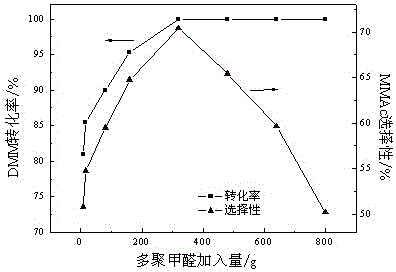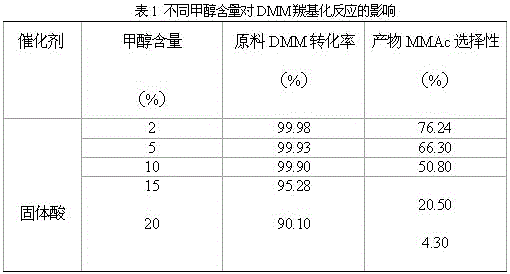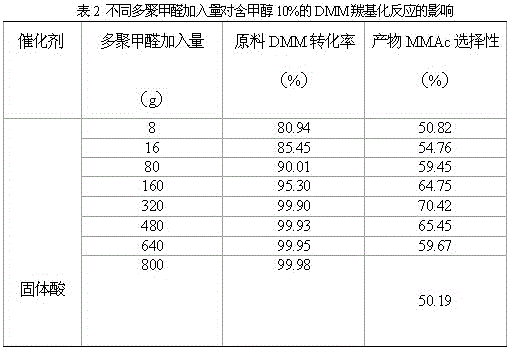Method for preparing methyl methoxyacetate from methanol-containing methylal
A technology of methyl methoxyacetate and methylal is applied in the preparation of organic compounds, the preparation of carbon monoxide or formate reaction, the preparation of carboxylate, etc., to achieve the effects of convenient source of raw materials, less pollution and less by-products
- Summary
- Abstract
- Description
- Claims
- Application Information
AI Technical Summary
Problems solved by technology
Method used
Image
Examples
Embodiment 1
[0049] Weigh 2L of methylal (DMM) containing a certain amount of methanol (2%, 5%, 10%, 15%, 20% (mass fraction)), 100 g of solid acid catalyst, and 320 g of paraformaldehyde into the reactor middle. Then pass in 1.0 MPa carbon monoxide gas, if there is no leak, after emptying the gas in the kettle, repeat the above operation twice (replace the air in the reaction kettle). Introduce a certain amount of gas (6.0 MPa) again to test for leaks, and let it stand for 15 minutes. If the pressure indicator does not drop, it means that there is no air leakage in the device. Then empty the gas in the kettle and fill the kettle with 6.0 MPa CO gas again. , heated up, the stirring speed of the reactor was 500 rpm, the reaction pressure was 6.0 MPa, the reaction temperature was 130°C, and the reaction time was 6 h. The reaction results are shown in Table 1.
[0050]
[0051] As can be seen from Table 1, with the increase of methanol content, the conversion rate of raw material DMM and ...
Embodiment 2
[0053] Weigh 2 L of methylal (DMM) containing 10% methanol, 100 g of solid acid catalyst, and a certain mass of paraformaldehyde (8, 16, 80, 160, 320, 480, 640, 800 g) into the reactor middle. Then pass in 1.0 MPa carbon monoxide gas, if there is no leak, after emptying the gas in the kettle, repeat the above operation twice (replace the air in the reaction kettle). Introduce a certain amount of gas (6.0 MPa) again to test for leaks, and let it stand for 15 minutes. If the pressure indicator does not drop, it means that there is no air leakage in the device. Then empty the gas in the kettle and fill the kettle with 6.0 MPa CO gas again. , heated up, the stirring speed of the reactor was 500 rpm, the reaction pressure was 6.0 MPa, the reaction temperature was 130°C, and the reaction time was 6 h. The reaction results are shown in Table 2.
[0054]
[0055] As can be seen from Table 2, along with the increase of paraformaldehyde addition, the DMM conversion rate also increas...
Embodiment 3
[0058] Add 100 g of solid acid catalyst in the reactor, 2 L of reaction raw material DMM containing 10% methanol, 320 g of paraformaldehyde. Then pass in 1.0 MPa carbon monoxide gas, if there is no leak, after emptying the gas in the kettle, repeat the above operation twice (replace the air in the reaction kettle). Introduce a certain amount of gas (6.0 MPa) again for leak detection, and let it stand for 15 minutes. If the pressure indicator does not drop, it means that the device has no air leakage. Then empty the gas in the kettle and inject 6.0 MPa pure CO gas. The reaction time 6 h, the reaction temperatures were 90, 100, 110, 130, 140°C, respectively. The reaction results are shown in Table 3.
[0059]
[0060] According to Table 3, it can be seen that with the increase of temperature (90, 100, 110, 120, 130°C), the conversion rate of raw material DMM is continuously increasing. When the reaction temperature is 130°C, the conversion rate of DMM is the highest at 99.90...
PUM
 Login to View More
Login to View More Abstract
Description
Claims
Application Information
 Login to View More
Login to View More - R&D
- Intellectual Property
- Life Sciences
- Materials
- Tech Scout
- Unparalleled Data Quality
- Higher Quality Content
- 60% Fewer Hallucinations
Browse by: Latest US Patents, China's latest patents, Technical Efficacy Thesaurus, Application Domain, Technology Topic, Popular Technical Reports.
© 2025 PatSnap. All rights reserved.Legal|Privacy policy|Modern Slavery Act Transparency Statement|Sitemap|About US| Contact US: help@patsnap.com



